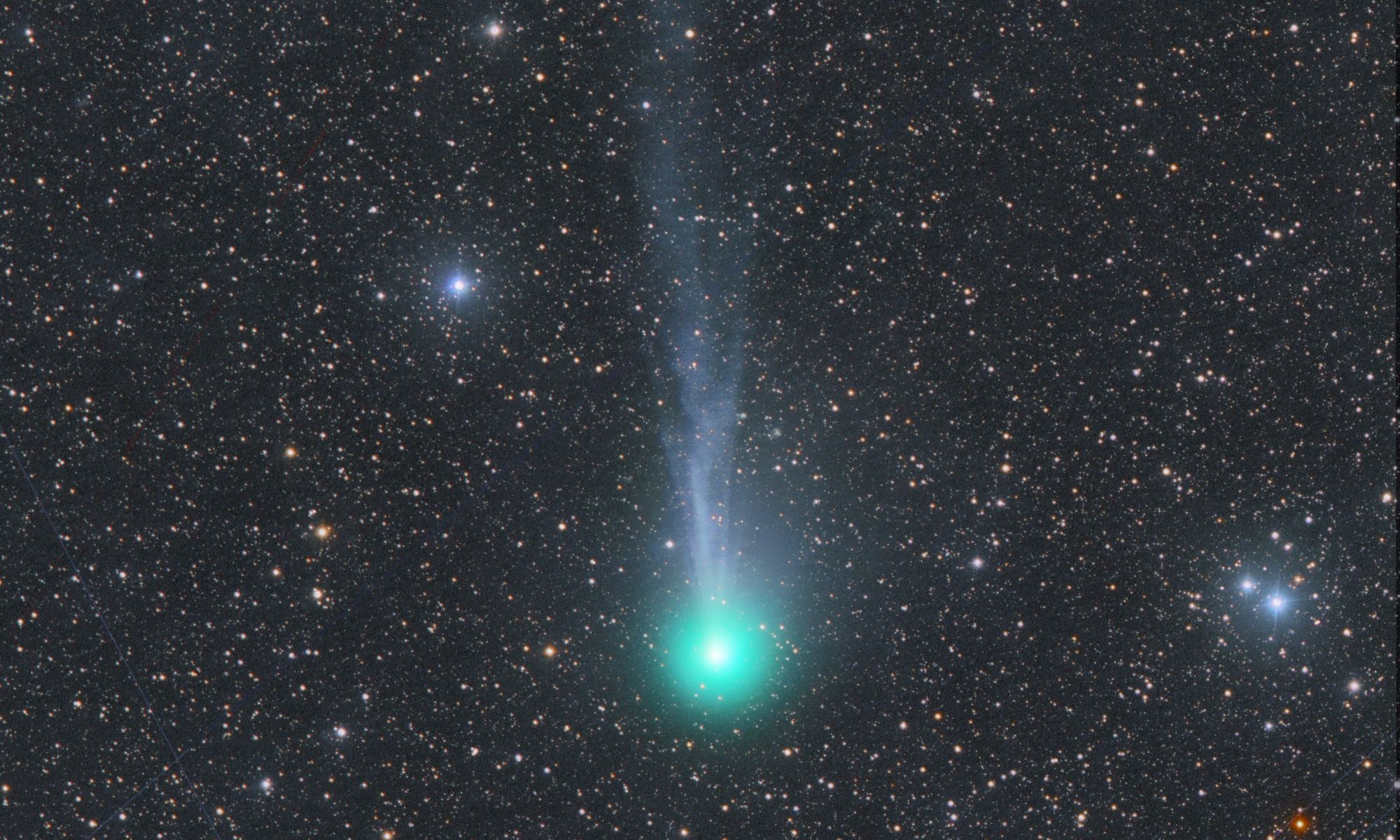Comet 12P Pons-Brooks takes center stage this Spring.
Something is definitely up with the 12th periodic comet in the catalog. We’re talking about Comet 12P Pons-Brooks, set to reach the first of two perihelia for the 21st century this Spring. And the timing couldn’t be better, as the comet will also sit near the Sun just two weeks prior during the total solar eclipse of April 8th 2024, spanning the North American continent from the southwest to the northeast. If the comet over-performs—a long shot, but multiple outbursts in 2023 suggest it just might—we could be in for the added treat of a naked eye comet near the Sun during totality.

The Intriguing Tale of Comet 12P
As of writing this, the comet is at magnitude +7.5 ‘with a bullet,’ well within range of binoculars. The comet will reach perihelion on April 21st, 2024, at 0.78 Astronomical Units (AU) from the Sun.

On a 71 year orbit (just a tad shorter than Halley’s Comet) Comet 12P can reach +5th magnitude on a favorable apparition. The name for the comet comes from the original discoverer astronomer Jean-Louis Pons, who first spotted the comet from the Marseilles Observatory in July 1812, and William Robert Brooks, who recovered the comet on the next apparition and cliched its periodic nature in 1883.

What 2023 Outbursts Mean for 2024
Keep in mind, an outburst near perihelion could vault Comet 12P up into naked eye brightness. Clearly, 12P Pons-Brooks has an active nucleus, estimated to be about 30 kilometers across. For context, Hale-Bopp had a nucleus estimated at 40-80 kilometers across. Comet 12P reached magnitude +4.5 during the last pass in 1954.

“My own thoughts on 12P is that it has been a wonderful surprise because it has been so active and with such unusual features,” astrophotographer Eliot Herman tells Universe Today. “There were predictions that 12P could be interesting from its past observations as an active comet, but I read the papers from prior passes and there are not that many images or drawings, and it appears that the observers of the era did not engage in constant monitoring.”
Herman is also collaborating with the British Astronomy Association’s campaign to observe the comet.
Tales of Two Comets
“You can compare 12P with 1P (Halley),” says astrophotographer Michael Jaeger. “Both are long-known periodic comets with a similar orbital period. Both are absolutely similarly bright. While 1P has its perihelion between Venus and Mercury, 12P only makes it slightly above the orbital plane of Venus.” This means that Pons-Brooks is generally not as spectacular as Halley’s Comet near perihelion. “Photographically, 12P already presents itself beyond the orbital plane of Mars with a faint ion tail that is more than 2 degrees long,” says Jaeger. “This will become significantly brighter over the next two months. this will give photographers the chance to take some spectacular images.”
Outbursts in 2023 shot the comet up a full 100-fold in brightness or five full magnitudes, reminiscent of the 2007 outburst from Comet 17P/Holmes which shot it up an amazing 15 magnitudes (one million times!) into naked eye brightness overnight. The 2023 outbursts gave Comet 12P/Pons-Brooks a ‘devil’s horns‘ look, reminiscent of Star Wars’ Millennium Falcon.

The 2024 apparition sees the comet well-placed for northern hemisphere observers at dusk, low to the northwest. The comet is approaching us along our line of sight and loiters across the constellations Lacerta into Andromeda and Pisces from February through April before taking the plunge southward across the ecliptic. After 2024, we won’t see Comet 12P Pons-Brooks again until 2095.

Here’s a look at comet 12P month-by-month in early 2024. As always, ‘passes near’ means less than one degree apart, unless otherwise noted:
February
9-Passes into the constellation Lacerta the Lizard
12-Passes near the +4th magnitude star 1 Lacertae
22-Passes into Andromeda the Princess
25-Passes 6 degrees from the Blue Snowball Nebula NGC 7662

March
9-Passes 8 degrees from the Andromeda Galaxy Messier 31
12-Passes between the stars Delta and Pi Andromedae
15-Passes into the constellation of Pisces the Fishes
19-Passes near the +4.5 magnitude star Tau Piscium
22-Photo op: passes just 3 degrees from the Pinwheel Galaxy Messier 33
27-Nicks the corner of the constellation Triangulum, then heads into the constellation of Aries the Ram
29-Passes near +4th magnitude star Lambda Arietis
31-Passes very near (less than 6’) from the +2nd magnitude star Hamal (Alpha Arietis)

April
8-Sits 24 degrees east of the Sun, during the total solar eclipse
11-Passes the ecliptic southward
14-Passes 3 degrees from Jupiter
20-Passes into the constellation of Taurus the Bull
21-Passes near 3.7 mag Xi Tauri, at perihelion

From there, the comet makes its closest Earth approach on June 2nd at 1.55 AU distant… but is much less favorably placed for observation in the southern constellation Lepus the Hare.
Don’t miss a chance to catch comet 12P/Pons-Brooks, coming to a sky near (or above) you.

